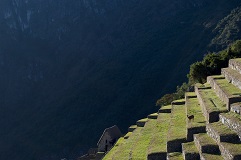The jungle has protected them for thousands of years. But erosion and especially modernity could well get the better of the thousands of earth mounds, vestiges of a vast Amazonian city some 2,500 years old, which has now disappeared, in the south-east of Ecuador.
“We thought they were simple natural structures” some of which were “razed to build roads”. “There is an urgent need for a protection plan,” pleads to AFP Alejandra Sanchez, a Spanish archaeologist who has been studying this heritage for around ten years.
Ecuadorian Machu Picchu
Already called by some the Ecuadorian Machu Picchu, the Upano site became famous in January 2024 when the reference journal Science published an article by French researcher Stéphen Rostain, who carried out excavations in the 1990s in what the media wrongly described as a novel “discovery”.
Ecuadorian archaeologist Alden Yépez shows photos of archaeological research carried out in the Ecuadorian Amazon, kept at the Weilbauer-Porras Museum of the Catholic University of Quito, February 2, 2024.
The publication evaded the work carried out over four decades by dozens of academics and archaeologists, as well as a project desired by the Ecuadorian state under the supervision of the National Institute of Cultural Heritage (INPC).
As part of this project initiated in 2015, some 7,400 mounds of earth were identified using laser technology used from an airplane to scan the soil under the thick plant cover.
In the shape of L, T, U, or even square, rectangle and oval, these mounds served as the foundation of the houses – of which nothing remains – to protect them from the damp ground.
In addition to recently built roads, erosion, deforestation and agriculture also endanger these massifs which measure up to four meters high and around twenty meters long. The Upano River, cradle of the indigenous culture of the same name, is the prey of illegal mining.
